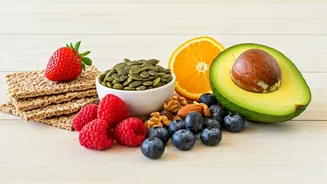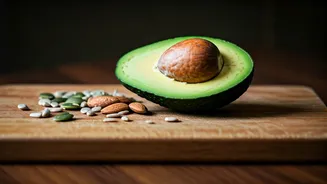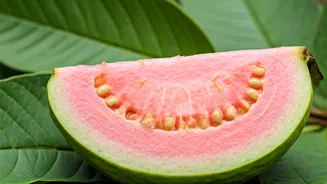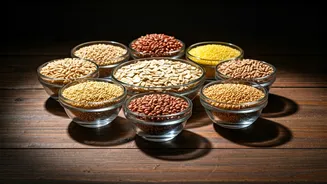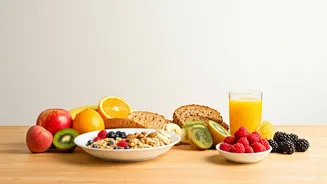Introduction: Grains and Blood Sugar
Understanding the role of grains in managing blood sugar is vital for anyone aiming to maintain stable glucose levels. Choosing the right grains can make
a significant difference in how your body processes carbohydrates. This introduction will set the stage by emphasizing the importance of dietary choices in managing blood sugar spikes. It lays the groundwork for why specific grains should be considered and why understanding the glycemic index and how they interact with the body is crucial for effective blood sugar control. The following sections will explore the top ten grains that are especially beneficial for people with diabetes or those looking to improve their health.
Oats: The Champion Grain
Oats are frequently cited as a top choice for blood sugar management because they are rich in soluble fiber, especially beta-glucan. This type of fiber slows down the absorption of glucose, preventing rapid blood sugar spikes after meals. It also aids in improving insulin sensitivity, a key factor in managing diabetes. Moreover, oats can contribute to improved heart health by helping lower cholesterol levels, an additional benefit for individuals managing diabetes who may be at a higher risk of cardiovascular issues. Including oats in your daily breakfast can offer a sustained release of energy throughout the morning.
Barley: Fiber-Rich Benefits
Barley is another excellent grain choice, celebrated for its high fiber content, which contributes significantly to regulating blood sugar. The soluble fiber in barley, like that in oats, slows down the digestion and absorption of carbohydrates, preventing sharp increases in blood sugar after eating. Regular consumption of barley can also help improve insulin response, enhancing the body's ability to use glucose effectively. Barley provides additional health benefits, like enhancing digestive health and providing essential nutrients. Barley can be incorporated in various meals, from soups to salads, to easily add this grain into your diet, offering a healthy alternative to refined grains.
Quinoa: A Complete Protein Source
Quinoa is a nutritional powerhouse that benefits blood sugar control due to its low glycemic index and high fiber content. It offers a complete protein, containing all nine essential amino acids, making it a valuable addition to any diet. Its slow digestion rate helps prevent blood sugar spikes, providing sustained energy. Additionally, quinoa is gluten-free, suitable for individuals with gluten sensitivities or celiac disease. Its versatility allows it to be used in salads, as a side dish, or in breakfast bowls. Quinoa's nutrient profile also offers other advantages, like assisting in weight management and providing essential vitamins and minerals.
Brown Rice: A Staple Choice
Brown rice stands out as a healthier alternative to white rice for anyone managing their blood sugar. Unlike white rice, which has had its bran and germ removed, brown rice maintains its fiber-rich outer layers. This fiber content helps slow down the absorption of glucose, which prevents blood sugar spikes. Brown rice also provides essential nutrients like magnesium and manganese, contributing to overall health. Including brown rice in your diet can be as easy as substituting it for white rice in your regular meals. It offers a good taste and texture and is a great option for people looking to improve their blood sugar management through diet.
Buckwheat: A Gluten-Free Option
Buckwheat is a gluten-free grain that is beneficial for blood sugar control, despite its name, it is not related to wheat. Buckwheat has a low glycemic index and high fiber content, which helps manage glucose levels effectively. It is rich in nutrients and antioxidants, providing additional health benefits. Buckwheat can be used in various recipes, such as pancakes, noodles, and porridge, offering versatility for people who want to incorporate it into their meals. Its ability to support stable blood sugar levels makes it an excellent choice for individuals with diabetes, adding it to their diet will help regulate blood sugar.
Millet: Nutrient-Packed Grain
Millet, an ancient grain, has gained popularity for its health benefits, including its role in blood sugar management. It has a low glycemic index and is rich in fiber, which promotes slow and steady release of glucose into the bloodstream. Millet also contains magnesium, which contributes to improving insulin sensitivity. This nutrient-packed grain is easy to prepare and can be used in various dishes, like porridge or as a side dish. By incorporating millet into your diet, you can enjoy its advantages in managing blood sugar and provide your body with several essential nutrients. Its subtle flavor makes it a versatile ingredient, perfect for diverse meal plans.
Amaranth: High in Protein
Amaranth is another grain that offers benefits for those aiming to control their blood sugar. It has a low glycemic index and is a complete protein, which means it contains all nine essential amino acids. This makes it an excellent option for building and repairing tissues while helping regulate blood sugar levels. Amaranth is also rich in fiber, which supports healthy digestion and slow glucose absorption. This grain can be used in numerous ways, such as in breakfast cereals, salads, or as a side dish. Including amaranth in your meals can provide sustained energy and support overall health.
Farro: Ancient Grain Advantage
Farro, an ancient grain, is increasingly recognized for its nutritional benefits, including its positive effects on blood sugar. It's a good source of fiber and has a lower glycemic index, which helps prevent blood sugar spikes after meals. Farro also offers a significant protein content, contributing to balanced energy levels throughout the day. Its nutty flavor and chewy texture make it a popular choice in various culinary applications, such as salads and side dishes. Adding farro to your diet can be a delicious and beneficial step towards managing your blood sugar levels and promoting overall well-being. Farro provides sustained energy and supports better metabolic health.
Freekeh: Young Wheat Grain
Freekeh, made from young, green wheat, is an excellent option for managing blood sugar due to its high fiber and protein content. It has a low glycemic index, which means it causes a slower and more gradual rise in blood sugar compared to many other grains. Freekeh is also a good source of prebiotics, promoting healthy gut bacteria and assisting with overall health. It has a nutty flavor and chewy texture, making it a great addition to salads, soups, and pilafs. Integrating freekeh into your diet can help with blood sugar regulation and also provide essential nutrients, which makes it a very beneficial grain to include in your diet.
Conclusion: Choosing Wisely
Incorporating the right grains into your diet is a key strategy for maintaining healthy blood sugar levels and promoting overall well-being. This article has detailed ten grains that can help with blood sugar management. Remember that these grains work best when combined with a balanced diet, including various fruits, vegetables, lean proteins, and healthy fats. Always consult your healthcare provider or a registered dietitian for personalized dietary advice. By making informed food choices, you can effectively manage your blood sugar and improve your overall health.


